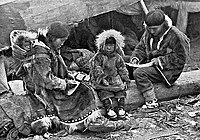Iñupiat
 Inupiat family King Island, Alaska | |
| Regions with significant populations | |
|---|---|
| North and northwest Alaska (United States) | |
| Languages | |
| Inupiat language, English | |
| Related ethnic groups | |
| Inuit |

The Iñupiat (plural) or Iñupiaq (singular) and Iñupiak (dual) (from iñuk 'person' - and -piaq 'real', i.e., 'real people') or Inupik are the people of Alaska's Northwest Arctic and North Slope boroughs and the Bering Straits region. Barrow, the northernmost city in the United States, is in the Inupiat region. Their language is known as Iñupiaq. There is one Inupiat culture-oriented institute of higher education, Iḷisaġvik College.
Inupiat people continue to rely heavily on subsistence hunting and fishing, including whaling. The capture of a whale benefits each member of a community, as the animal is butchered and its meat and blubber allocated according to a traditional formula. Even city-dwelling relatives thousands of miles away are entitled to a share of each whale killed by the hunters of their ancestral village. Maktak, which is the skin and blubber of Bowhead and other whales, is rich in vitamins A and C[1][2] and contributes to good health in a population with limited access to fruits and vegetables.

In recent years oil and other resources have been an important revenue source for the Inupiat. The Alaska Pipeline connects the Prudhoe Bay wells with the port of Valdez in south central Alaska. However, because of the oil drilling in Alaska’s arid north, the traditional way of whaling is coming into conflict with one of the modern world’s most urgent priorities: finding more oil.[3]
Inupiat people have grown more concerned in recent years that climate change is threatening their traditional lifestyle. The warming trend in the Arctic affects the Inupiaq lifestyle in numerous ways, for example: thinning sea ice makes it more difficult to harvest Bowhead Whales, seals, walrus, and other traditional foods; warmer winters make travel more dangerous and less predictable; later-forming sea ice contributes to increased flooding and erosion along the coast, directly imperiling many coastal villages. The Inuit Circumpolar Council, a group representing indigenous peoples of the Arctic, has made the case that climate change represents a threat to their human rights.
Inupiaq groups in common with other Eskimo/Inuit groups, often have a name ending in "miut," which means 'a people of'. One example is the Nunamiut, a generic term for inland Inupiaq caribou hunters. During a period of starvation and influenza (brought by American and European whaling crews, see John Bockstoce's 1995 Whales, Ice, & Men: The History of Whaling in the Western Arctic) most of these moved to the coast or other parts of Alaska between 1890 and 1910. A number of Nunamiut returned to the mountains in the 1930s. By 1950, most Nunamiut groups, like the Killikmiut, had coalesced in Anaktuvuk Pass, a village in north-central Alaska. Some of the Nunamiut remained nomadic until the 1950s.
Further reading
- Heinrich, Albert Carl. A Summary of Kinship Forms and Terminologies Found Among the Inupiaq Speaking People of Alaska. 1950.
- Sprott, Julie E. Raising Young Children in an Alaskan Iñupiaq Village The Family, Cultural, and Village Environment of Rearing. West, CT: Bergin & Garvey, 2002. ISBN 0313013470
- Chance, Norman A. The Eskimo of North Alaska. Holt, Rinehart and Winston, 1966. ISBN 0-03-057160-X
- Chance, Norman A. The Inupiat and Arctic Alaska: An Ethnology of Development. Holt, Rinehart and Winston, 1990. ISBN 0-03032419-X
- Chance, N.A. and Yelena Andreeva. "Sustainability, Equity, and Natural Resource Development in Northwest Siberia and Arctic Alaska." Human Ecology. 1995, vol 23 (2) [June]
References
- ^ Vitamin C in the Diet of Inuit Hunters From Holman, Northwest Territories
- ^ Vitamin C in Inuit traditional food and women's diets
- ^ Mouawad, Jad."In Alaska’s Far North, Two Cultures Collide." New York Times.December 4, 2007. Retrieved on 2009-02-11.[1]
